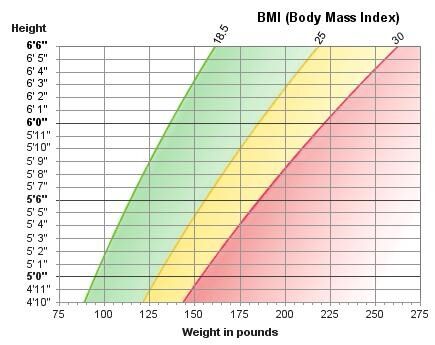
Body Mass Index (BMI)
In this article we’ll look at body mass index, or BMI, in more detail.
BMI
In the discussion about weight, you may hear BMI being mentioned a lot. But what is BMI? And how do you calculate it? In our article below we’ll look at Body Mass Index, or BMI, in more detail.
What is BMI?
BMI is a value, like mph, that uses your weight divided by your height to calculate kg/m2.
BMI is a rule of thumb that can be used to broadly categorise a person as underweight, normal weight, overweight, or obese. If your BMI is:
- Below 18.5 (kg/m2) you’re categorised as underweight
- Between 18.5 and 24.9 you’re categorised as a healthy weight
- Between 25 and 29.9 you’re categorised as overweight
- Between 30 and 39.9 your categorised as obese
How do I calculate BMI?
The easiest way to work out your BMI is to use a BMI calculator like this one on the NHS website.
You can also see what range you fall within using a chart like the one below.

BMI Limitations
BMI was invented in the 1830s and, in the subsequent 200 years, better measures of health have emerged. Mathematician Nick Trefethen stated “BMI divides the weight by too large a number for short people and too small a number for tall people. So short people are misled into thinking that they are thinner than they are, and tall people are misled into thinking they are fatter." [1]
The 4 main issues with BMI, according to obesity experts, are: [2]
- It doesn’t indicate body fat, so a tall or muscular person may have a low body fat percentage but high BMI
- It drastically differs depending on gender (a man and a woman with identical body fat percentage could have very different BMIs)
- A high BMI doesn’t automatically equal overweight
- It doesn’t consider waist circumference which is a better indicator of health
Waist Circumference
Having excess body fat around your middle have been linked with an increased risk of Type 2 Diabetes and heart attacks. [3, 4] Excess means more than 34.5 inches for women and more than 40 inches for men.
In a study of 340,000 people from 8 European countries in 2012 found that overweight people with large waists were at a similar risk of developing diabetes as people who were clinically obese. This link was strongest in female participants. [5]
Another study that finished in 2016 took the measurements of nearly 500,000 adults with no risk of heart disease sometime between 2006 and 2010. Within the time between having their measurements taken and the study coming to an end, close to 6,000 of the participants had a heart attack. People with a high waist measurement were significantly more likely to have a heart attack during the study. Again, this link was stronger in women.
[4] https://www.ahajournals.org/doi/full/10.1161/jaha.117.008507
[5] http://journals.plos.org/plosmedicine/article?id=10.1371/journal.pmed.1001230

